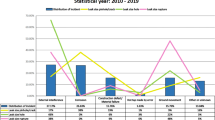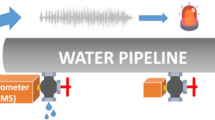Abstract
The inspection of a pipeline from the inside becomes more and more widespread. An inspection tool, called “Geometry Pig”, carries a variety of sensors, among which a strapdown inertial system provides essential geometric information on the pipeline. In this paper the inspection pig is described as a surveying tool, which delivers information on centre line, shape and features of the pipe. After some background information it is explained, why the inertial system is the optimal instrument to deliver some structural parameters of the pipeline. The interaction between data evaluation and measurement procedure is discussed in view of the very few possibilities to vary the procedure. One of them is a forced rotation about the forward axis. Analogies are shown to traditional surveying procedures. Finally some results of actual surveys are presented. A positioning accuracy of 1:2500 is achieved with respect to tie points.
Similar content being viewed by others
References
Beller, M. and U. Schneider (1990): Pipeline Inspection with the Intelligent Ultrasonic Pig (in German). Erdöl, Erdgas, Kohle 106, p. 19–23
Britting, K.R. (1971): Inertial Navigation Systems Analysis, Wiley-Interscience, New York
Condor Pacific Industries (1989), Inc., Canoga Park, California: Land Navigation System Condor CLN-100 Specifications. CLN-1 89020601, Feb. 1989
Diesel, J.W. (1987): Calibration of a Ring Laser Gyro Inertial Navigation System. 13th Biennial Guidance Test Symposium, Holloman Air Force Base, New Mexico, Oct. 1987, Vol. 1, p. 1–37.
Grafarend, E.W. (1974): Optimization of Geodetic Networks. Canad. Surv. 28(5), p.716–723
Heitz, S. (1986): Fundamentals of Kinematic and Dynamic Models of Geodesy (in German). Mitteilungen a.d. Geodät. Inst. d. Rheinischen Friedrich-Wilhelms-Universität Bonn, 2.ed. Bonn, ISSN 0723-4325
Huddle, J.R. (1988): Advances in Strapdown Systems for Geodetic Applications, in: K. Linkwitz, U. Hangleiter (eds.): High Precision Navigation, Proc. of an Int. Workshop in Stuttgart and Altensteig, May 1988, Springer, Berlin 1989, ISBN 3-540-50921-6, p. 496–530
Knickmeyer, E.H., P.M. Brown and J. Meikle (1992): Control of Pipeline Deformations by Surveys from the Inside, to appear in: Proc. 6th Int. FIG-Symp. on Deformation Measurements, Geodetic Inst., Univ. of Hanover, Feb. 24–28, 1992
Knickmeyer, E.H. and E.T. Knickmeyer (1991): Basic Geometric Considerations for a Self-Calibration of Strapdown Inertial Sensor Blocks by Tumbles, in: K.P. Schwarz and G. Lachapelle (eds.): Kinematic Systems in Geodesy, Surveying and Remote Sensing, Springer-Verlag, New York, p. 105–116.
Knickmeyer, E.H., K.-P. Schwarz and P.J.G. Teunissen (1988): Strapdown — an Inertial Navigation Concept for Engineering Applications (in German), in: K. Schnädelbach, H.Ebner(eds.): Ingenieurvermessung 88, Beiträge zum X. Int. Kurs für Ingenieurvermessung, München 12.–17.9.1988, Dümmler, Bonn, p. A4/1–14
Knickmeyer, E.T. (1991): Accuracy of Gravity Vector Recovery with the LTN 90–100 RLG Inertial Strapdown System, in: K.P. Schwarz and G. Lachapelle (eds.): Kinematic Systems in Geodesy, Surveying and Remote Sensing, Springer-Verlag, New York, p. 498–509.
Levinson, E. and R. Majure (1987): Accuracy Enhancement Techniques Applied to the Marine Ring Laser Inertial Navigator (MARLIN), Navigation 34, p.64–86
Martell, H.E. (1991): Applications of Strapdown Inertial Systems in Curvature Detection Problems, MSc Thesis, Publ. # 20043 Dept. of Surveying Eng., University of Calgary, Calgary
Matthews, A. and H. Welter (1989): Cost-Effective, High-Accuracy Inertial Navigation, Navigation 36, p. 157–172
Mueller, I.I. (1981): Inertial Survey Systems in the Geodetic Arsenal, Keynote Address, Proc. Second Int. Symp. on Inertial Technology for Surveying and Geodesy, June 1–5, 1981, Banff, Alberta, Canada, p.11–33
Porter, T.R., H.E. Martell, K.-P. Schwarz and J.R. Adams (1990): The Inertial Pipeline Pig: An Autonomous System for Pipeline Monitoring, Proc. XIX Congress of the FIG, paper no. 512.3, Helsinki, Finland, June 1990
Price, P.St.J., R.L. Wade and H.A. Anderson (1990): Pipeline geometry pigging: Data acquisition, data management and structural interpretation, Pipeline Pigging and Integrity Monitoring Conference, Holiday Inn Hotel, Aberdeen, 5–7 November 1990, Organized by Pipes & Pipelines International, PO Box 21, Beaconsfield, Bucks HP9 1NS, UK
Schäfler, R., and W. Heger (1986): Inertial Surveying of Mining Shafts (in German), in: Caspary, Hein, Schödlbauer (eds.): Beiträge zur Inertialgeodäsie, Schriftenreihe Studiengang Vermessungswesen, Heft 22, University of the Federal Armed Forces Munich, Munich, p. 261–275
Schwarz, K.-P. (1986): The Error Model of Inertial Geodesy — a Study in Dynamic System Analysis, in: H. Sünkel (ed.): Mathematical and Numerical Techniques in Physical Geodesy, Lecture Notes in Earth Sciences, Vol. 7, Springer, Berlin, p. 463–504
Stieler, B. and H. Winter (1982): Gyroscopic Instruments and their Application to Flight Testing, AGARDograph No.160 Vol.15
Tiratsoo, J.N.H. (ed.) (1988): Pipeline Pigging Technology, Gulf Publishing Company, Houston
Author information
Authors and Affiliations
Rights and permissions
About this article
Cite this article
Knickmeyer, E.H. The Rolling Pig or How does a surveyor creep through a pipeline?. Bulletin Géodésique 68, 71–76 (1994). https://doi.org/10.1007/BF00819383
Received:
Accepted:
Issue Date:
DOI: https://doi.org/10.1007/BF00819383




